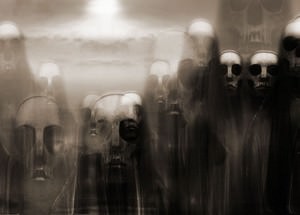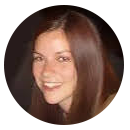Sleep Paralysis Visions: Cleaning The Doors of Perception
 With Halloween around the corner, it's socially acceptable to talk about ghosts and spirits for the next couple weeks. We decorate out homes with fake gravestones and spider
webs, dress ourselves up as scary-sexy zombies-vampires, and watch creepy movies on
the television. After November 1, all the costumes and decorations go into a box, the Halloween candy is shipped to remainder stores for deep discounts, and we forget about
the ghosts and ghouls until next year.
With Halloween around the corner, it's socially acceptable to talk about ghosts and spirits for the next couple weeks. We decorate out homes with fake gravestones and spider
webs, dress ourselves up as scary-sexy zombies-vampires, and watch creepy movies on
the television. After November 1, all the costumes and decorations go into a box, the Halloween candy is shipped to remainder stores for deep discounts, and we forget about
the ghosts and ghouls until next year.
Unless you regularly experience sleep paralysis, that is.
For those few of us with a penchant for SP and its attendant visions, the veil between worlds is always a bit thin. For those of us who wake up and find we cannot move, nor cry out, and - what's more - there's a vampire standing in the doorway, every night contains a prospect for encountering this spooky underworld of consciousness.
Chances are, if you are a lucid dreamer who has tried lucid dreaming methods that disturb the sleep cycle - such as wake-back-to-bed (WBTB) or supplements like galantamine - you have run into sleep paralysis once or twice. You may have also found that the rules are a little different with SP. That's why I recommend all lucid dreamers familiarize themselves with this misunderstood state of consciousness, and, in particular, look into it as an opportunity for a powerful spiritual experience.
Hallucinations versus Visions
By "spiritual" I don't mean the vague, scented-candled and New Aged concept about the interconnectedness of the universe, but actually the experience of contacting spirits. This is the original definition of spiritual.
Spirits: what else to call the monsters, ghosts, and wispy creatures that show up at the foot of the bed during a bout of sleep paralysis? They aren't human, they certainly are not from this material realm, and calling them "hallucinations" is only a distancing method that banks on character assassination, an attempt to rationalize that what's plainly here is not here. When someone uses the term hallucination, it deflates the experience and suggests it is meaningless.
So I call these uncanny encounters sleep paralysis visions. This restores their potential value and primary reality, and is closer to the other traditions of the world that are more accepting of seeing nebulous things in the night. SP visions are not random, but have powerful psychological effects that influence a person's beliefs for the rest of their lives.
Why do I think these visions are meaningful? They are one of the original sources of fairy tales, myths and religious stories around the world, including visitations from the dead, encounters with angels, sexual molestation by demons, succubi and witches, and quite possibly some modern alien abduction narratives.
They are real encounters, happening when the mind is awake and alert. But let's not be fundamentalist about what "reality" is either. These encounters are not happening in what we term consensual reality, that realm we ordinarily share and make group observations, but rather occur during a range of altered states that are most easily accessed through sleep, but also can be accessed by trance, hallucinogens, and shamanic techniques such as drumming and chanting.
I prefer to call this liminal reality, an anthropological term that comes from the Latin as "threshold." When we are in sleep paralysis, we are in between worlds: ordinary reality where our bodies are sleeping, and the dreamworld, where our imagination is keeping company with some very old and powerful creative energies that appear to play with everything we think we know and turn it upside down. In sleep paralysis, we are literally trapped in the threshold between worlds.
The Science of Sleep Paralysis Visions
At this point, I should point out that while we know quite a bit about the physical mechanisms of sleep paralysis, we know very little about the visions themselves. Rebecca's introductory article is an excellent place to start, covering the causes and the symptoms of this hybrid state of awareness, as well as how sleep paralysis relates to REM sleep. An easy way to think of it is Mind Awake, Body Asleep. Knowing that SP occurs as REM intrusion into Stage N-1 sleep - the lightest stage of sleep - may be helpful for those who think they are going insane.
Let me be clear: you are not going insane. No, apparently this is part of normal life; we just aren't allowed to talk about it in polite society because it is the reservoir for just about every taboo our culture holds.
The physiology of REM defines many features of this unique vision state, including the predominance of negative emotions - especially fear and horror, as well as intense sexual longing and unparalleled access to long term memory. In other words, our childhood fears and longings are prevalent in SP visions, as our the myths, tales and belief structures that cemented when we were young and more accustomed to dealing with extreme fear and existential horror.
This modified REM brain state allows for the default expression of SP visions:
- the scary encounter with an unknown figure that simply watches from behind a hooded cloak
- the terrifying experience of ghost rape that nonetheless results in orgasm
- contact with a vampire, alien or teethy creature that seems to drain you of will, courage and possibly more.
Angels, Ancestors and Orgasms
But physiology is not destiny. Many people, myself included, have had SP encounters with figures that are warm, inviting, and radiating with healing light. Others speak of contact with the recently deceased, or of figures dressed in period clothing that want nothing more but to ask a few questions. What starts as a SP attack can transform into an otherworldly journey - the kind we see in the Old Testament - as well as out-of-body experiences and lucid dreams.
Positive sexual encounters in SP are possible too, although I suspect they are under- reported due to the nested taboos of admitting the enjoyment of intercourse with a ghost or invisible being. Interestingly, just a few weeks ago the pop star Kei$ha admitted to having sex with a ghost, and her account was immediately denounced as a PR stunt to correspond with her new single Supernatural.
Maybe, maybe not.
When you go looking, you find these encounters are hidden in plain sight. Kei$ha isn't the first celebrity to admit having sex with a ghost: ten years ago, Lucy Liu says she went there (and enjoyed it), and Anna Nicole Smith also publicly recounted a having multiple sexual encounters with ghost when she lived in Texas.
Skeptics may doubt the power of these encounters, but don't worry about them: skeptics are just trying to protect their world view. As lucid dreamers, we know that reality is malleable. The same is true of SP encounters. Our own beliefs about what is possible while we are in contact with the "Stranger in the room" can influence what we perceive. In many cases, I have watched the sleep paralysis entity shape-shift as my own thoughts, fears and attitudes shifted.
Like lucid dreams, the figure is unstable, and often has a "doppelganger" effect that mirrors our own beliefs. You can see a similar effect in lucid dreams when standing in front of a mirror. It can be an intense exercise - as you flow back and forth between self- love and doubt - but it's well worth the trouble.
The Phenomenological Attitude
Yet, I am convinced the identity of the Stranger is more than our psychological projection in the moment; it is not "just" a recreation of our worse nightmare. Rather, each night visitor should be considered a unique, autonomous constellation of energy that has a range of visages. I wish I had a pat answer on who they are and where they come from, but I would be lying to say I understand. As a researcher, and in my own SP encounters, I try to maintain openness to the experience and a suspension of disbelief. This is called the phenomenological attitude: it's basically a Western version of meditation.
Notice your thoughts; notice your attitudes and fears as they occur, but then set them aside and breath in the new moment.
I have found this practice to be very difficult, but ultimately rewarding. In my experience, the identity of the SP entity can shift into a more communicative figure, although there is still a tremendous range of identities possible. On the other hand, sudden spikes of fear or distrust can cause the Stranger to take on a more "trickster-like" role, and the event can quickly go downhill into full-on nightmarish horror again. If this happens, you can always wake yourself up using a variety of SP awakening techniques.
The phenomenological attitude doesn't wash away the presence, but rather can be seen as a process of cleaning the doors of perception. When you're stuck in the threshold between dreams and waking, in that liminal space, a clean threshold comes in handy.
So when you find yourself face to face with the ghosts, goblins and werewolves of sleep paralysis visions, remember that the each moment brings new possibilities. Some may always choose to wake up, and that's fine. However, if you choose to go through the threshold - using the mind's ability to be open, discerning and above all compassionate - many new doorways will open beyond this first gate.
For more about the history, culture, science and - most importantly - how to work with sleep paralysis visions, I invite you to check out my ebook on the topic: Sleep Paralysis Kit.
About the Author
 Ryan Hurd is a dream researcher, blogger and author of several
books and e-courses on sleep, nightmares and advanced lucid dreaming. He is the editor
of DreamStudies.org and a board member of the International Association for the Study
of Dreams. In late 2012, look for him at TEDMED.com as a Challenge leader, tackling
the problem of sleeplessness in our society.
Ryan Hurd is a dream researcher, blogger and author of several
books and e-courses on sleep, nightmares and advanced lucid dreaming. He is the editor
of DreamStudies.org and a board member of the International Association for the Study
of Dreams. In late 2012, look for him at TEDMED.com as a Challenge leader, tackling
the problem of sleeplessness in our society.

 Next: Sleep Paralysis Kit Review
Next: Sleep Paralysis Kit Review














